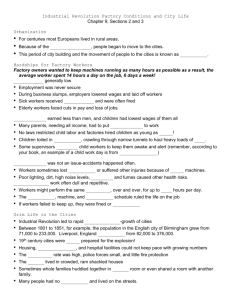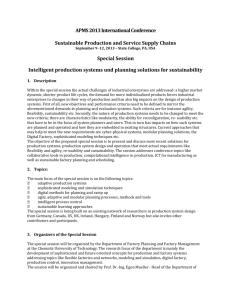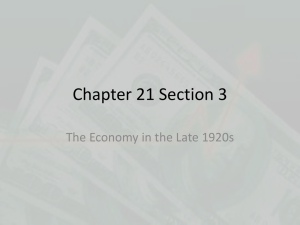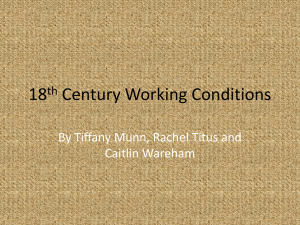Industrial Revolution
advertisement
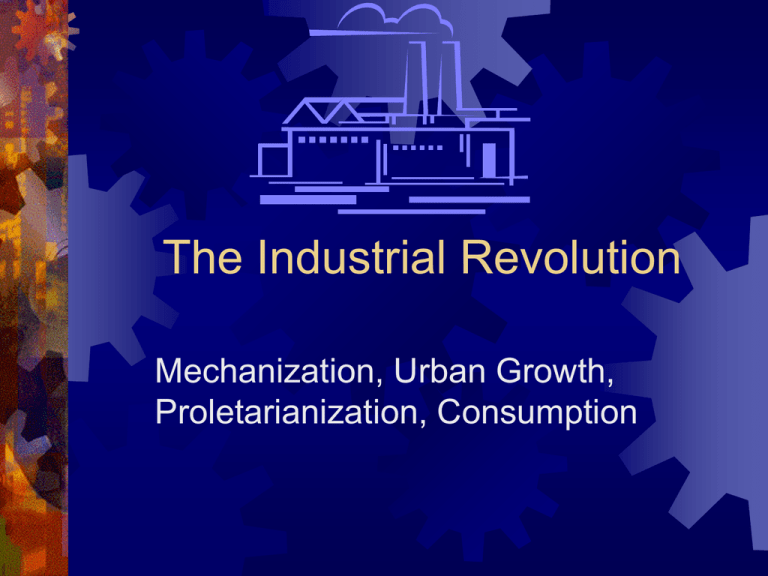
The Industrial Revolution Mechanization, Urban Growth, Proletarianization, Consumption Mechanization During the first half of the 19th century, the European manufacturing process shifted from small-scale, holistic production by hand at home to large-scale, prescriptive production by machine in a factory setting. At the Expense of Workers The shift meant high quality products at competitive prices, but often at the expense of workers. For example, the raw wool and cotton that fed the British textile mills came from: Lands converted from farming to sheep raising, leaving farm workers without jobs The southern plantations of the United States, which were dependent upon slave labour The impact… Alienation Rise in labour movements and demands for unions Socialist ideas – Marx and Engels “Communist Manifesto” - 1848 of the workers? Worksheet - Look up the different responses to Industrial Revolution Urban Growth Those who could no longer make a living on the land migrated from the countryside to the cities to seek work in the factories. 1850: Population Living in Cities 100 75 50 25 0 England & Wales 50 25 % Population France & Germany Eastern Europe Population Growth At the same time, the population of Europe continued to grow. Millions 40 30 20 1831 1851 10 m an y G er ce Fr an En gl an d 0 The Plight of the Cities The sheer number of human beings put pressure on city resources: Housing, water, sewers, food supplies, and lighting were completely inadequate. Slums grew and disease, especially cholera, ravaged the population. Crime increased and became a way of life for those who could make a living in no other way. Conditions in the Countryside The only successful farmers were those with large landholdings who could afford agricultural innovations. Most peasants: Didn’t have enough land to support themselves Were devastated by poor harvests (e.g., the Irish Potato Famine of 184547) Were forced to move to the cities to find work in the factories. Florence Nightingale Became an advocate and educator for rural hygiene and standards. The Role of the Railroads The railroads, built during the 1830s and 1840s: Enabled people to leave the place of their birth and migrate easily to the cities. Allowed cheaper and more rapid transport of raw materials and finished products. Created an increased demand for iron and steel and a skilled labor force. The Labour Force No single description could include all of these 19th century workers: Factory workers Urban artisans Domestic system craftsmen Household servants Miners Countryside peddlers Farm workers Railroad workers Variations in duties, income, and working conditions made it difficult for them to unite. The Condition of Labour All working people, however, faced possible unemployment, with little or no provision for security. In addition, they were subject to various kinds of discipline: The closing of factory gates to late workers Fines for tardiness Dismissal for drunkenness Public censure for poor quality workmanship Beatings for non-submissiveness Prolitarianization During the century, factory workers underwent a process of proletarianization (i.e., they lost control of the means of production). Factory owners provided the financial capital to construct the factory, to purchase the machinery, and to secure the raw materials. The factory workers merely exchanged their labor for wages. Family Structures Changed With the decline of the domestic system and the rise of the factory system, family life changed. At first, the entire family, including the children, worked in the factory, just as they had at home. Later, family life became fragmented (the father worked in the factory, the mother handled domestic chores, the children went to school). Family as a Unit of Consumption In short, the European family changed from being a unit of production and consumption to being a unit of consumption alone. Gender-Determined Roles That transformation prepared the way for gender-determined roles. Women came to be associated with domestic duties, such as housekeeping, food preparation, child rearing and nurturing, and household management. The man came to be associated almost exclusively with breadwinning. Political Changes The introduction of liberalism in the 18th century meant a new age in British politics, which continued through the Industrial Revolution In Britain, Gladstone (Liberal) and Disraeli (Conservative) were two of the most influential political leaders of the late Industrial Revolution Both advocated reform of social structure; as a result, some of the more productive governments came to power Liberalism Emphasized rationalism, importance of individual happiness (individualism) Role of state is to protect the freedom and rights of the individual Believed that human rights would be lost if government intervened Generally, reflected views of middle class Conservatism Believed in value of traditional life More government necessary to control society and preserve general order Generally had a less optimistic view of human nature than liberals Reflected views of landed upper class Laissez Faire: No Government Intervention Held a very pessimistic view of the possibilities for improvement in the living standards of the poor Laissez faire would optimize economic growth (also known as free market) Utilitarianism: Government Intervention and Regulation Jeremy Bentham (1748-1832) agree with Adam Smith’s argument that it was best to free individuals to pursue their own selfinterest Social Legislation New Poor Law drafted in 1834, which was based on the pleasure / pain calculation called the “less eligibility principle.” In order to receive poor relief, an individual had to enter a workhouse and in order to discourage people from going on relief, conditions in the workhouse were designed to be worse than the conditions outside. Protesters saw workhouse as prisons and named them “Bastilles” Remained until 1909 About 5 percent of the population was dependent on the New Poor Law The Factory Act of 1833 – prohibited the employment of children under nine and placed limits on working hours of those between the ages of 9 and 18 Factory Act of 1847 – limited children to 10 hour day. This limit became the standard working day for adults in textile mills. The Mines Act of 1842 – prohibited the employment of women and of children under 10 years of age, in underground mines. With the conditions workers had to endure and the outbreak of killer diseases, Edwin Chadwick helped draft the Public Health Act of 1848, which included a General Board of Health to overseas conditions The social legislation redefine the government’s role in social policy. It established new ways of investigating social problems and created a body of professional civil servants.

